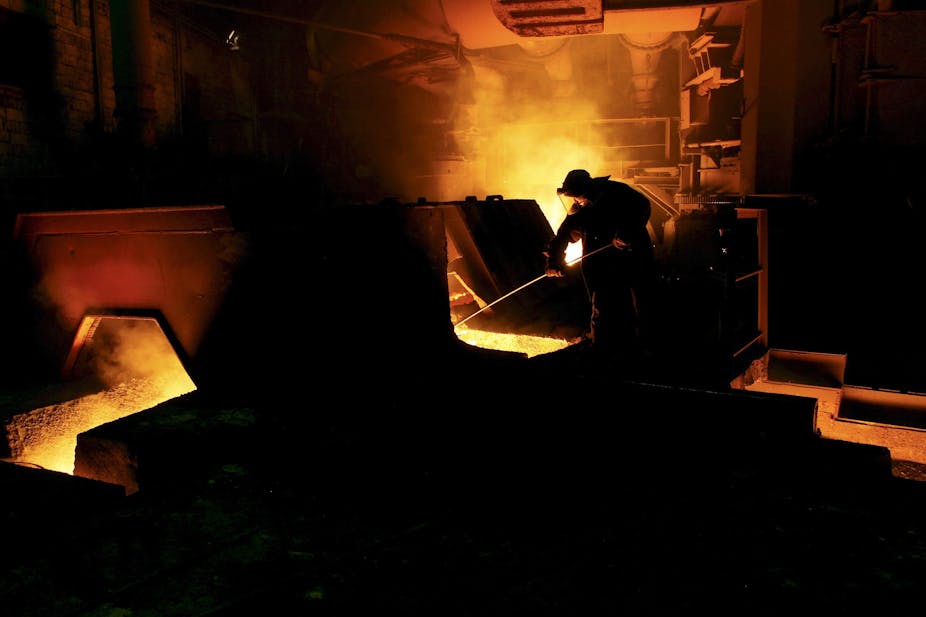The recent furore about the carbon tax in this country has not been a celebration of enlightened debate.
I think much of the debate misses a vital aspect of carbon use, namely, that using carbon to make metal is an effective way of storing energy and that whatever approach we use to move industry to a lower carbon future should reflect this principle.
Let me explain.
Carbon, in the form or coal or hydrocarbons we recover from underground, is a form of stored energy. Once we recover these materials from the earth’s crust, this stored energy can be used in two major ways. We can use it to generate heat, which in turn, we can use to produce work (that is, we can generate electricity). Or, we can make it react with ores to produce metal.
The conversion of energy into heat and work is the focus of a major science: thermodynamics. In fact, the science of thermodynamics was initially developed by a French Engineer (Carnot) who was trying to make sense of why English steam engines used coal more efficiently than their French counterparts.

Carnot and several brilliant scientists in the 19th century established the key principles of how energy is transferred into heat and work. These general principles hold true for rocket engines, solar panels, coal powered electricity generators and even our bodies. Sadly, most people discussing energy in the media haven’t studied thermodynamics!
What thermodynamic analysis tells us is that there are limits to how effectively we can convert energy into work. In the case of coal powered electricity generation, this analysis tells us that we will lose over half the stored energy in coal as waste heat during the process. In the case of some of the old power plants used in Victoria, this waste figure is well over 60%.
This level of loss is typical in thermal processes (such as fires, stoves, combustion) and difficult to overcome. In most cases, the heat and work released by burning coal is dissipated or lost directly after its use. To compound the problem, there are significant losses associated with transferring electrical energy in power lines over long distances.
Let’s compare this way of using carbon with its use in metallurgical production. In the blast furnaces at Whyalla and Port Kembla, the carbon (in the form of coke) is used to break the chemical bond between oxygen and iron in iron ore to form iron, which is then converted to steel.
The coal also provides heat required for the ironmaking process. In efficient furnaces, roughly 600kg of coal is used to produce 1 tonne of iron. Blast furnaces are quite efficient in terms of energy, with heat losses being closer to 20% than the 60 to 70% associated with power generation.

There is also another major difference with this use of coal compared to power generation. Metals can be readily recycled. In fact, steel and aluminium (the world’s two major metals) can be recycled many times over. When they are recycled, far less energy is used than that is initially used to make virgin metals. In the case of steel, this saving is about half. For aluminium, the savings are over 90%. Once you have made a metal, you have effectively embedded the energy associated with the coal into a new form.
We should value metal more highly. Throwing away an aluminium can or dumping a car in a forest is, effectively, throwing away energy. Every tonne of steel that we recycle saves us having to dig a couple tonnes of ore and another tonne of coal from the ground. I would argue that once have done the hard work of converting the coal into something useful and recoverable, we should show more respect for the value of the embedded energy in that object.
Recent discussions and policies around carbon usage do not distinguish between these two activities. Our laws and policies don’t differentiate between the impact of burning a tonne of coal to generate electricity for providing light for empty offices at night and using the coal to make some metal, which we can re-use over and over again.
Part of the problem is the unsophisticated public discussion of energy issues in this country. The embedded energy argument, familiar to many engineers and scientists, is not widely appreciated and certainly rarely discussed in public life.
In a carbon constrained future, we will need to consider very carefully how we use the carbon we do have available. We need to start questioning not just how much carbon we use for a particular activity but how much of the energy we have just used can be recovered later.
In short, we need re-think how we use the carbon resources available to us.

